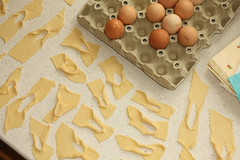
The Italian influence on the Polish cuisine dates back to the thirteenth and fourteenth centuries when there were significant trade links with the Polish merchants of Genoa, Florence and Venice.
In the fourteenth century the court bills mentioned that royal cooks used fruit such as figs, raisins, almonds and lemons. In the fourteenth century Italian cuisine reached only the aristocratic mansions.

Bronisław Abramowicz "Wierzynek banquet"
The opinion that the Italian Queen Bona brought vegetables to Poland is untrue, since lettuce, beets, cabbage, turnips, carrots, peas and cauliflowers had been eaten as early as at the court of King Jagiello. The undeniable thing is that Queen Bona employed only Italians as cooks. They were also hired for the preparation of receptions for magnates. At the court of Queen Bona very large quantities of fruit were used. They included oranges, lemons, pomegranates, olives, figs, chestnuts, raisins, almonds and Italian vegetables, rice and various kinds of roots: black pepper, fennel, saffron, ginger, nutmeg, cloves, cinnamon, sugar, marzipan and olive oil.

Jan Matejko "Poisoning of Queen Bona"
Most Polish names of vegetables are derived from the Italian language (cauliflower, artichokes, leeks, onion, asparagus, beans, zucchini, lettuce). In the nineteenth century tomatoes, scorzonera, endive, spinach and chicory joined the list.
The Polish confectionery was created by Italians. The domain of Italian confectioners was ice cream, doughnuts, sugary drinks such as lemonade and orange soda and a chocolate cake with fruit and jelly, fruit syrups and fried chestnuts.
Doughnuts, which probably originate from the Roman Empire, currently are the symbol of Polish carnival.
On the last Thursday of the carnival in Poland Fat Thursday is celebrated . This day nobody counts calories and everybody eats doughnuts or other fried sweets. This tradition was born in Krakow in the sixteenth century where Queen Bona organized carnival balls. That's why Fat Thursday on my table is dominated by doughnuts and Faworki.

Pieter Bruegel "The Fight Between Carnival and Lent"
Last year I published a recipe for doughnuts. Today I publish a recipe for Faworki. This recipe came from my Grandmother's kitchen notebook. She didn’t like Italian cuisine and doughnuts. She didn’t understand my fascination with Italian cuisine but she made the best Faworki in the whole country. The taste of these sweets reminds me of her and our discussions about cuisine. She died a few weeks ago and she left me the notebook full of old recipes. Thanks Grandma.
 FAWORKI
FAWORKI500g flour
5 egg yolks
100 ml fresh crème
2 tbsp rum
½ tsp salt
fat for deep frying
icing sugar
Flour, yolks, fresh crème, rum and salt mix together. Mix with your hands well, slowly and obviously with pleasure. Knead until the dough reaches a flexible consistency. When dough doesn’t stick to your hands it is ready.
Divide dough into four parts, and roll each one out very thin. Cut on strips 5 cm long and 2 cm wide. Make an incision 2 cm long in the middle part of each strip. Each strap take in his hand and horn of strap to scroll through an incision in the middle until you get a cookie similar to the one in the picture.

heat up a fat in wide pot. When it is hot put few Faworki and fry for gold colour one side and turn on and fry second side. Ready Faworki put on plate and sprinkle they with icing sugar and fry next part of cookies.
Serve cold down.
Enjoy!!!
Similar posts:
From doughnuts to herrings - Polish Shrovetide

Thanks for sharing your ingredients! they are amazing and this one is really a hit from your blog, I discovered and appreciated much more recipe.
ReplyDeletezonia